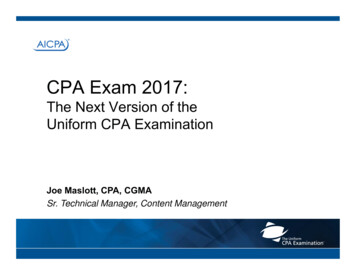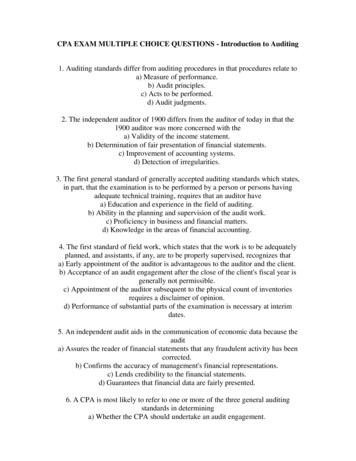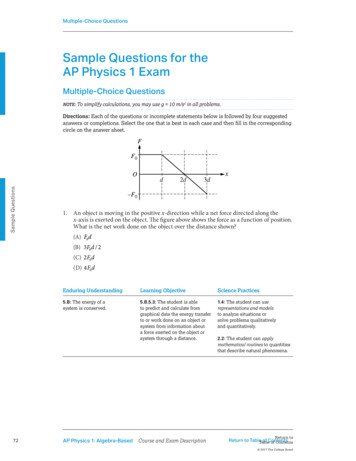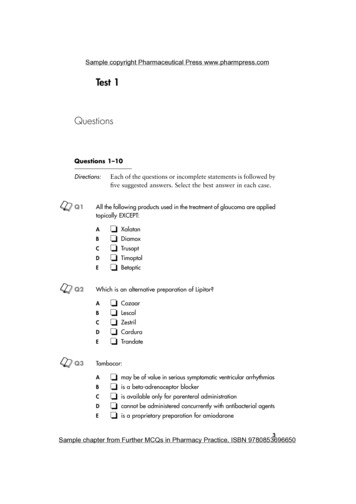
Transcription
MULTIPLE CHOICE QUESTIONS (MCQs)[/caption]Physics Multiple Choice Questions (MCQs) On Circular MotionClass 11 Physics - Important Question answer for students preparing for XI Board .Physics Multiple Choice Questions (MCQs) on the topic of Circular Motion.MULTIPLE CHOICE QUESTIONS (MCQs)1. A body is moving along a circular path with variable speed, it hasa) A radical accelerationb) A tangential accelerationc) Zero accelerationd) Both radical and tangential acceleration2. A body is traveling in a circle at a constant speed.Ita) has a constant velocityb) has no acceleration
c) has an inward accelerationd) has an outward radial acceleration3. A car sometimes overturns while taking a turn. When it overturns, it isa) The inner wheel which leaves the ground firstb) The outer wheel which leaves the ground firstc) both the wheel leave the ground simultaneouslyd) Either inner wheel or the outer wheel leaves the ground4. A particle is performing a U.C.M. Which is the wrong statement regarding its motion?a) The velocity vector is tangential to the circleb) The acceleration vector is tangential to the circlec) The acceleration vector is directed towards the center of the circled) The velocity and acceleration vectors are perpendicular to each other5. A particle is acted upon by a force of constant magnitude which is alwaysperpendicular to the velocity of the particle? The motion takes place in a plane.It follows thata) its velocity is constantb) its acceleration is constantc) its motion is lineard) its motion is circular6. A stone is tied to one end of a string. Holding the other end, the string is whirled in ahorizontal plane with progressively increasing speed. It breaks at some speed becausea) Gravitational forces of the earth are greater than the tension in the string.b) The required centripetal force is greater than the tension sustained by the string.c) The required centripetal force is less than the tension in the string.d)The centripetal force is greater than the weight of the stone.
7. In a vertical circle of radius r at what point in its path, a particle has a tension equal tozero?a) Highest pointb) Lowest pointc) Any pointd) A horizontal point8. For a particle performing a U.C.M. the acceleration isa) constant in directionb) constant in magnitude but not in the directionc) constant in magnitude and directiond) constant in neither magnitude nor in direction9. An airplane is taking a turn in a horizontal planea) its remains horizontalb) it inclines inwardc) it inclines outwardd )its wings become vertical10. When particle revolves with uniform speed on a circular patha) no force acts on itb) no acceleration acts on itc) no work is done by itd) its velocity is constantAnswers
Ans1. (d) Both radical and tangential accelerationAns2. (c) Has an inward accelerationAns3. (a) The inner wheel which leaves the groundFirst CircleAns4. (b) The acceleration vector is tangential to theAns5. (d) Its motion is circularAns6.(b) The required centripetal force is greater thanThe tension sustained by the string.Ans7. (a) Highest pointAns8.(b) constant in magnitude but not in the directionAns9.(b) it inclines inwardAns10. (c) no work is done by itSHORT ANSWER QUESTIONSQ1. Define circular motion.Ans1. It is a movement of an object or body, along a circular path.Q2. i)Which of the following remains constant in a uniform circular motion,speed or velocity or both?ii) Name the force required for uniform circular motion. State its direction.Ans2. i) Speed remains constant in a uniform circular motion.ii) Centripetal force is required for uniform circular motion.Centripetal force is directed towards the center.
Q3.An airplane tilts when it makes a curved flight, why? Explain.Ans3. An airplane tilts when it makes a curved flight because the weight of the airplanegets used in providing it the necessary centripetal force.Q4. Why a force is necessary to keep a body moving with uniform speed in acircular path?Ans4. A force (centripetal force) is required to keep a body moving with uniform speedin a circular motion because if no centripetal force will act on the moving body it willstrike the sides of the roads.Q5. What is the centripetal force?Ans5. The centripetal force on a body is defined as the external force which causes thebody to move in a circular path with a constant speed and acts along the radius andtowards the center of the circular path.a rω2 Fc mrω2Q6. What is Centrifugal force?Ans6. The outward forces acting on bodies when they move in circular paths are calledcentrifugal forces.centrifugal force mv2rIt is not a real force but a fictitious force and is due to the inertial property of the body.Q7. In a circus why does not a motorcyclist fall down when he moves on thevertical walls of the “wall of death”?Ans7. In a circus, a motorcyclist does not fall down when he moves on the vertical wallsof the wall of death because of the centripetal force that keeps the motorcyclist in acircular path.Q8. Explain why the earth is flattened at the poles.Ans8. The earth is flattened at the poles because of the gravitational pull of the moonand the sun.
Q9. Why does a cyclist lean inwards while rounding a curve?Ans9. When cyclist tends to move in a curved path, sidewise frictional forces come intoplay between the tires and the road. The forces of friction act towards the center ofthe curved path and hence provide necessary centripetal force and cyclists leaninwards while rounding a curve.Q10. Why are curved railway tracks banked?Ans10.When a fast-moving train takes a curved path, it tends to move awaytangentially off the track. In order to prevent this, the curved tracks are banked on theoutside to produce the necessary centripetal force required to keep the train moving ina curved path.LONG ANSWER QUESTIONSQ1. Distinguish between centripetal and centrifugal force. A body of mass m ismoving with uniform velocity v on a circular path of radius r. Find themagnitudes and direction of force acting on it.Centripetal force:It is defined as the inward force acting on a body when it moves in a circular path. Thisforce is directed towards the center of the circular path.It is given by,F mv2rmv2rCentripetal force:It is defined as the outward force experienced by a body moving in a circular path.It is directed away from the centre. Its magnitude is equal to that of centripetal force. Centripetal force (F) mv2rmv2r mrω2mrω2
Figure:Let us consider a body of mass ‘m’ is moving in a circular path of radius ‘r’ with uniformspeed ‘v’. The velocity of the body is changing due to direction. At any instant, thebody is at point A.Let VA VA be the velocity of the body at AAfter time ΔΔT, the body reaches point BLet VB VB be the velocity of the body at B.Change in velocity is, VA VBLet us draw a vector triangle PQR. So, that the triangles AOB and PQR are similartriangles because both are an isosceles triangle with the same vertex angle.OA/OB PQ/PRor,r/AB V/ΔV--------------- ii)In a similar triangle, the ration of the corresponding side is equal.
We know,Distance speed x timeAB V*ΔtPutting the value of AB in equation ii)r/VΔt V/ΔVV/ΔV v2/ra v2/r --------------- (iv)It gives the centripetal acceleration.F maF mv2/rBy Newton’s 2nd law of motion,It gives centripetal forceAs we have,V ωrThen,F mω2r2/rF mω2rIt gives centripetal force in terms of angular velocity.Q2. Explain:A) The force of gravity acts on all bodies in proportion to their masses, why doesnot a heavy body fall faster than a light body?B) In what factor does the orbital velocity of an earth satellite depends?C) Why is the orbital speed of an earth satellite in circular orbit constant?D) What is meant by geostationary satellite?Ans2.
(A) The force of gravity acts on all bodies in proportion to their masses, but a heavybody fall faster than a light body due to presence of air.(B) V orbit GMR GMROrbital velocity on an earth satellite depends upon the-Gravitational constant G-Mass of the body at center M-The radius of the orbit R(C) A satellite orbiting about the earth in a circular motion is moving at a constantspeed and remains at the same height above the surface of the earth. It accomplishesthis feat by moving with a tangential velocity that allows it to fall at the same rate atwhich the earth curves. At all instance during its trajectory, the force of gravity acts in adirection perpendicular to the direction that the satellite is moving. Since perpendicularcomponents of motion are independent of each other, the inward force cannot affectthe magnitude of the tangential velocity. For this reason, there is no acceleration in thetangential direction and the satellite remains in a circular motion at a constant speed.(D) The geostationary satellite is the one whose orbital motion is synchronized with therotation of the earth. In this way, the synchronous satellite remains always over thesame point on the equator as the earth spins on its axis.Q3. What is the Uniform Circular Motion?Ans3. Uniform Circular Motion can be described as the motion of an object in a circularpath at a constant speed.It is possible for a body to move in a circular path with uniform speed as long as it istraveling equal distances in equal intervals of timeThe velocity of the body moving in a circle with uniform speed is not uniform becausethe direction of motion is constantly changing.Examples of Uniform Circular Motion:Artificial satellites move in uniform motion around the earth. Therefore, the motion of asatellite around the earth is accelerated.The moon moves in a uniform circular motionaround the earth. We know that the moon is a natural satellite of the earth. Similarly, wecan say that the movement of the earth around the sun is also a uniform circularmotion. So, the motion of the earth around the sun is accelerated.
Q4. What is Non-uniform Circular Motion?Non-uniform circular motion denotes a change in the speed of the particle movingalong the circular path. In non- uniform circular motion, the size of the velocity vector(speed) changes, denoting the change in the magnitude of velocity.The change in speed has implications for radial (centripetal) acceleration. There aretwo possibilities: the radius of the circle is constantThe radial (centripetal) force is constant.In either case, the angular velocity in a non-uniform circular motion is not constant, asω vrω vr, and vv varies
Q5. (a) A constant torque of 1.56 N-m is applied to a rotating solid disk of radius15 cm and mass 5.71 kg. What is the angular velocity of the disk after 10seconds?(b) A string 1 meter long is used to whirl a. 50 kg. Stone in a vertical circle. What isthe tension in the string when the stone is at the top of the circle moving at5.0m/s.Ans5. (a) Torque T 1.56 NmRadius r 15 cm 0.15 mMass m 5.71 kgTime t 10 sInitial angular velocity w0 of the disc is not given. We assume it to be zero.Final angular velocity of the disc w w0 atWhere a is the angular accelerationAnd torque T I aWhere I is the moment of inertia, which for a solid disc, about an axis passing through itscenter and perpendicular to it is ½ mr2hence I ½ x 0.15 x 0.15 x 5.71 0.064hence a 1.56 / 0.064 24.28and w 24.28 x 10 242.8 rad/s(b) R 1 m, m 0.50 kg, VH 5 m/sTension at the highest point:TH (mvH2)/r- mg ((0.50 x 52)/1) - 0.50 x 9.8 12.54.9 7.6 N.–
For more information, video lectures, study material, sample papers, CBSE Class 11Physics, register withTakshila Learning.Follow us on a Social mediaFollow us on BlogaramaCall at 8800999280 / 8800999283 / 8800999284Tag - physics multiple choice questions (mcqs); mcq on circular motion; Physics MCQQuestions for Class 11 with Answers Pdf Download; class 11 physics MCQs; PhysicsQuestion Answer:
force is directed towards the center of the circular path. It is given by, F mv2rmv2r Centripetal force: It is defined as the outward force experienced by a body moving in a circular path. It is directed away from the centre. Its magnitude is equal to that of centripetal force. Centripetal force (F) mv2rmv2r mrω2mrω2










